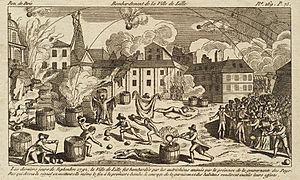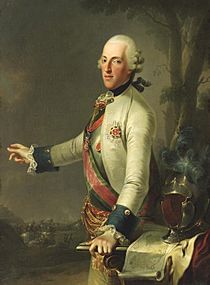Siege of Lille (1792) facts for kids
Quick facts for kids Siege of Lille (1792) |
|||||||
|---|---|---|---|---|---|---|---|
| Part of the War of the First Coalition | |||||||
 Siege of Lille by Louis Joseph Watteau |
|||||||
|
|||||||
| Belligerents | |||||||
| Commanders and leaders | |||||||
| Strength | |||||||
| 10,000–25,000 | 13,800, 52 siege guns | ||||||
| Casualties and losses | |||||||
| 100–200 |
43 dead, 161 wounded 20 siege guns |
||||||
The Siege of Lille (September 25 – October 8, 1792) was an important event during the War of the First Coalition. A French army, led by Jean-Baptiste André Ruault de La Bonnerie, defended the city of Lille against an attack by the Austrian army. This army was commanded by Duke Albert of Saxe-Teschen.
Even though the city was heavily bombed, the French soldiers successfully held their ground. The Austrians could not fully surround Lille. This allowed the French to keep bringing in more soldiers and supplies. After the French won a big battle at Valmy, Duke Albert pulled his troops and cannons away. The French victory at Lille was celebrated across France. A monument called the Column of the Goddess was built later to remember this siege.
Contents
Lille's Strong Defenses
After France took control of Lille in 1668, a famous military engineer named Sébastien Le Prestre de Vauban was asked to make its defenses even stronger. He built a five-sided fort, called a citadel, between 1668 and 1672. It cost a lot of money, about 1.5 million florins. Vauban proudly called it the "Queen of Citadels."
The citadel was surrounded by swamps, except where it met the city. It had two flooded ditches and two hidden paths for protection. In 1670, parts of the old city walls were taken down to make space for new defenses. When the work was finished, Lille was protected by 16 strong points called bastions and four outer defenses called hornworks. Vauban thought that 12,000 soldiers were needed to defend these huge fortifications. This included 1,000 soldiers just for the citadel.
Why the Siege Happened
In 1792, France was going through big changes with its revolution. Other European countries, like Austria and Prussia, were worried. They formed a group called the Coalition to fight France.
On August 19, a French general named Gilbert du Motier, Marquis de La Fayette left his army. He went into the Coalition's territory. The French government had called him back to Paris to answer questions. He was even accused of treason, which is a very serious crime. La Fayette was then imprisoned by the Austrians and Prussians until 1797.
Charles François Dumouriez took over La Fayette's army. Dumouriez wanted to invade the Austrian Netherlands (modern-day Belgium). But other events made him wait. On August 24, news arrived that the French town of Longwy had fallen to the Coalition. Then, on September 2, the Coalition won another battle at Verdun.
The main Coalition army, led by Duke Charles William Ferdinand of Brunswick, was moving towards Paris. Dumouriez quickly moved his troops to stop them. He also called for more soldiers to join him. On September 20, the French and Coalition armies fought at the Battle of Valmy. The French won, and Brunswick's army began to retreat from France.
While Dumouriez was busy fighting Brunswick, Duke Albert of Saxe-Teschen decided to attack other French positions. He wanted to draw French soldiers away from Brunswick's path. On September 5, Austrian troops moved towards Lille. The French soldiers defending the area had to retreat. This made Duke Albert decide to lay siege to Lille.
The Siege of Lille
Duke Saxe-Teschen decided to besiege Lille because his earlier attacks had caused panic among the French. On September 16, he gathered about 15,000 soldiers and 50 cannons. He arrived to join the siege on September 25.
Lille was a very strong fortress. It had a good supply of everything needed and a garrison of 3,000 regular soldiers. These defenders were led by Jean-Baptiste André Ruault de La Bonnerie. The number of defenders quickly grew to 10,000 men.
The Austrian attack had a problem: they did not have enough siege cannons, and their army was too small to completely surround Lille. Because of this, the French could keep bringing in more soldiers and supplies without any trouble.
On September 24, the Austrians pushed back the French outposts and started digging trenches that night. They set up five batteries with 30 cannons. Duke Saxe-Teschen asked Lille to surrender, but Ruault refused. Ruault's soldiers made attacks every night, but they could not stop the Austrians from building their siege works.
On September 29, the Austrian cannons began a very strong bombardment. They fired cannonballs, shells, and even hot-shot (heated cannonballs) at Lille. Fires started in the city, but citizens formed bucket brigades to put them out. The French cannons inside the city fired back heavily.
Ruault's forces soon grew to 25,000 men. This was many more soldiers than the Austrians had. By October 3, the Austrian bombing started to slow down. On October 4, Duke Saxe-Teschen's wife, Maria Christina, Duchess of Teschen, visited the Austrian camp. The bombing then became very intense again.
By this time, Saxe-Teschen learned that Brunswick's army was retreating. He also saw that more and more French troops were gathering against him. On October 6, the Austrian commander ordered his heavy siege cannons to be removed. By then, 60,000 shots and shells had been fired into Lille.
The Austrians left their trenches on October 8 and pulled back. The people of Lille came out of their city. They were so angry about the damage that they completely destroyed the Austrian siege works. The victory at Lille was celebrated all over France. It also encouraged many men to join the French armies.
The Armies
The French garrison in Lille, led by Ruault, started with 10,000 men. This included soldiers from different infantry and cavalry regiments, as well as National Guard battalions. More soldiers arrived in the city during the siege.
A general named Charles François Duhoux was supposed to be in charge of Lille. But he was ordered to another camp just before the siege began. He returned to Lille on September 23 to take command. However, a few days later, he was suspended and told to report to Paris. He stayed in Lille during the siege and only went to Paris on October 10. He was criticized by newspapers but said it would have been cowardly to leave Lille during the attack.
The Austrians had 13,800 soldiers for the siege of Lille. They also brought 52 cannons, howitzers, and mortars. Duke Saxe-Teschen divided his army into three main groups. These groups included different infantry battalions and cavalry squadrons.
An interesting group was the "Légion franche de cavalerie des Américains et du Midi". This light cavalry unit was formed in September 1792. It was made up of volunteers from the West Indies and Africa, as well as European-whites. Chevalier de Saint-Georges was a captain in Lille and later became a colonel in this legion. Alexandre Dumas, a famous writer's father, was also an officer in this unit.
What Happened Next
The French army had about 100 to 200 soldiers killed or wounded during the siege. The Austrians reported 43 dead and 161 wounded. They also lost 20 siege cannons, which either broke or became unusable from firing so much.
The Austrians really had little chance of capturing such a strong fortress. Ruault told the government that about a quarter of the houses in Lille were burned. Other reports said 500 houses were destroyed and 2,000 more were damaged. The Church of Saint-Étienne was also ruined. Some people thought the damage might have been made to sound worse for political reasons.
With the main Coalition army retreating, Dumouriez saw a chance. He realized that the large number of French troops gathered to defend Lille could now be used for his plan to invade Belgium. He got permission from the French government to start his attack. Soon, he had between 80,000 and 100,000 soldiers ready. Duke Saxe-Teschen was in a very difficult situation. The next major battle was the Battle of Jemappes on November 6, 1792.
Images for kids





